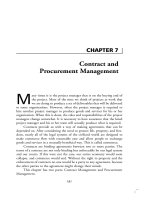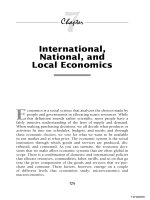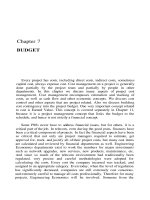Chapter 7 reducing project duration
Bạn đang xem bản rút gọn của tài liệu. Xem và tải ngay bản đầy đủ của tài liệu tại đây (2.58 MB, 20 trang )
Source: Mc Graw Hill Education. All Rights Reserved, 2021
CHAPTER 7:
REDUCING PROJECT DURATION
© 2021 McGraw-Hill Education. All rights reserved. Authorized only for instructor use in the classroom.
No reproduction or further distribution permitted without the prior written consent of McGraw-Hill Education.
McGraw-Hill/Irwin 9–2
Rationale for Reducing Project Duration
• Time Is Money: Cost-Time Tradeoffs
–Reducing the time of a critical activity usually incurs
additional direct costs.
• Cost-time solutions focus on reducing (crashing) activities on the
critical path to shorten overall duration of the project.
–Reasons for imposed project duration dates:
• Customer requirements and contract commitments
• Time-to-market pressures
• Incentive contracts (bonuses for early completion)
• Unforeseen delays
• Overhead and goodwill costs
• Pressure to move resources to other projects
3
Options for Accelerating Project Completion
• Adding Resources
• Fast-Tracking
• Outsourcing Project
Work
• Critical-Chain
• Scheduling Overtime
• Establishing a Core
Project Team
• Reducing Project
Scope
• Compromise Quality
• Do It Twice—Fast and
Correctly
4
Explanation of Project Costs
• Project Indirect Costs
– Costs that cannot be associated with any particular work
package or project activity.
• Supervision, administration, consultants, and interest
– Costs that vary (increase) with time.
• Reducing project time directly reduces indirect costs.
• Direct Costs
– Normal costs that can be assigned directly to a specific
work package or project activity.
• Labor, materials, equipment, and sub-contractors
– Crashing activities increases direct costs.
5
Reducing Project Duration to Reduce
Project Cost
Identifying direct costs to reduce project time
Gather information about direct & indirect
costs of specific project durations.
Search critical activities for lowest direct-cost
activities to shorten project duration.
Compute total costs for specific durations and
compare to benefits of reducing project time.
6
Project Cost—Duration Graph
FIGURE 9.1
7
Constructing a Project Cost—Duration Graph
• Find total direct costs for selected project durations.
• Find total indirect costs for selected project
durations.
• Sum direct & indirect costs for these selected
project durations.
• Compare additional cost alternatives for benefits.
8
Constructing a Project Cost—Duration Graph
• Determining Activities to Shorten
– Shorten the activities with the smallest increase in cost
per unit of time.
– Assumptions:
• The cost relationship is linear.
• Normal time assumes low-cost, efficient methods to complete the
activity.
• Crash time represents a limit — the greatest time reduction
possible under realistic conditions.
• Slope represents a constant cost per unit of time.
• All accelerations must occur within the normal and crash times.
9
Activity Graph
FIGURE 9.2
10
Cost—Duration Trade-off Example
FIGURE 9.3
11
Cost—Duration Trade-off Example (cont’d)
FIGURE 9.3 (cont’d)
12
Cost—Duration Trade-off Example (cont’d)
FIGURE 9.4 (cont’d)
13
Cost—Duration Trade-off Example (cont’d)
FIGURE 9.4 (cont’d)
14
Cost—Duration Trade-off Example (cont’d)
FIGURE 9.4 (cont’d)
15
Summary Costs by Duration
FIGURE 9.5
16
Project Cost—Duration Graph
FIGURE 9.6
17
Practical Considerations
• Using the Project Cost—Duration Graph
• Crash Times
• Linearity Assumption
• Choice of Activities to Crash Revisited
• Time Reduction Decisions and Sensitivity
18
What if Cost, Not Time is the Issue?
• Commonly Used Options for Cutting Costs
– Reduce project scope
– Have owner take on more responsibility
– Outsourcing project activities or even the entire project
– Brainstorming cost savings options
19
Key Terms
Crash point
Crash time
Direct costs
Fast-tracking
Indirect costs
Outsourcing
Phase project delivery
Project cost–duration graph
20









